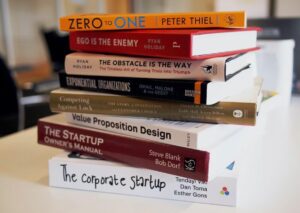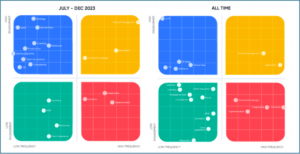The concept of the curated professional self is often on display on LinkedIn, especially over the summer when people feel compelled to share their ‘holiday reading lists’.
I find many of these posts mildly amusing, especially the ones filled with business strategy books. For some reason, no one wants to admit to reading a romance or a spy story in their down time. You have to be ‘always on!’, constantly striving to advance your knowledge and ergo your career/business.

This looks like a seriously dull holiday.
The number of business strategy books I have acquired over the years take up minimal space on my bookcase. The ones I have read from cover to cover take even less.
That said, one that did capture and successfully retain my attention is Blue Ocean Strategy, written by a couple of Professors from INSEAD (‘the World’s Business School’).

First published in 2005, Blue Ocean Strategy was already an international best seller by the time I added it to my bookcase. Full of fascinating case studies on brands and products like Nintendo Wii, Cirque de Soleil, Marvel, and Yellow Tail wines, the core concept at the centre of the book is the idea of the Blue Ocean – the uncontested market space where the competition is rendered irrelevant.
In the Blue Ocean, you are not forced to make the usual trade-offs around price and quality to be competitive, you can pretty much set your own value equation.
The opposite of the Blue Ocean is the Red Ocean, so called because its crowded and everyone is competing like sharks, often on price, resulting in a lot of ‘blood in the water’.
Yellow Tail wines is a fascinating case study covered in the book.
By making wine more accessible (in terms of the language and the taste), the Aussie owned brand became huge in the US, famously selling more bottles there in one year than all French wines combined.
For those interested, the secrets to Yellow Tail’s success were to (initially) offer a small range (1 red and 1 white), blended in a way that would be inoffensive to most palates, and to dial up the fun (cue Crocodile Dundee costumes and various Australiana references).

Whereas here it’s taste profile would be considered too sweet and bland, in the US it opened up wine to a whole new audience, and when you are talking about a market of quarter of a billion people, even a niche can become super profitable.
Blue Ocean advisor conversations – based on millions of data points
The concept of the Blue Ocean has continued to resonate with me strongly. Brands with the courage to create their own space and play by their own rules (Apple have been thinking differently for years) can be truly inspiring.
I was excited to be able to bring the concept to life in a slightly different context for our recently released ‘What Advisors Want’ (second edition) Research paper.
Based on the thousands of conversations taking place across the Ensombl platform, and using Natural Language Processing AI to look at over 2 million data points, we were able to track the frequency of – and engagement with – each and every conversation.
In the context of What Advisors Want, we have defined a Red Ocean topic as one that scores high for frequency but low for engagement. The conversations taking place around these topics are shallow and transactional and it is harder for brand voices to differentiate themselves. They are ‘Business as Usual’ topics.
Blue Ocean topics are those with high ‘novelty value’. They are less frequently discussed, but when they are, the interest and engagement is high. These are the topics and conversations where brands can truly stand out and truly connect with advisors – and use less resources when doing so (great for ROI).
Because we mapped frequency against engagement we actually end up with a four-box grid, effectively giving us four different oceans:
- Blue Ocean: High engagement, low frequency.
- Red Ocean: High frequency, low engagement
- Amber Ocean: High engagement, high frequency.
- These are hot topics but highly competitive, meaning differentiation is
highly resource intensive.
- These are hot topics but highly competitive, meaning differentiation is
- Green Ocean: Low frequency, low engagement.
- Topics which tend to be highly technical, specialised, or niche.
We mapped the Blue Ocean conversations across all time (effectively as far back as 2020) as well as for the second half of 2023, and the results were interesting.

They showed that of the most frequent conversations in H2 2023, those with the highest engagement included AdviceTech and practice management. Those with lower engagement included superannuation and insurance (these conversations were quite shallow, and tended to revolve around referrals or answers to technical or product questions).
The Blue Ocean conversations – lower frequency but far more interesting to advisors – included HR, platforms, fees and strategy.
Even more interesting, those 4 were in the Blue Ocean over both the time periods we looked at.
So what does this mean?
Amber Ocean topics are high interest and high frequency, so while there is no doubt content based around those topics will resonate widely, it will also have to work harder to stand out from the crowd. It will be more resource intensive. Owning a hot topic can obviously provide brand and positioning benefits, so the hard work can certainly pay off.
On the other hand, content based around HR (job descriptions, salaries, performance reviews, recruitment), pricing advice, and strategy (value proposition, org structure, mergers and acquisitions, client segmentation etc) is less common but is eagerly consumed. This content is especially appealing to the advisors who are also business owners and are looking to grow. They are the forward-thinking advisors that many brands would do well to capture the attention of.
And the best bit is, there aren’t many other brands in this ocean, making it easier to stand out, enabling a better ROI.
Now that’s a strategy I can agree with.
You can download What Advisors Want here.
For more advisor insights from the Ensombl platform, feel free to reach out to any of the Ensombl team.

